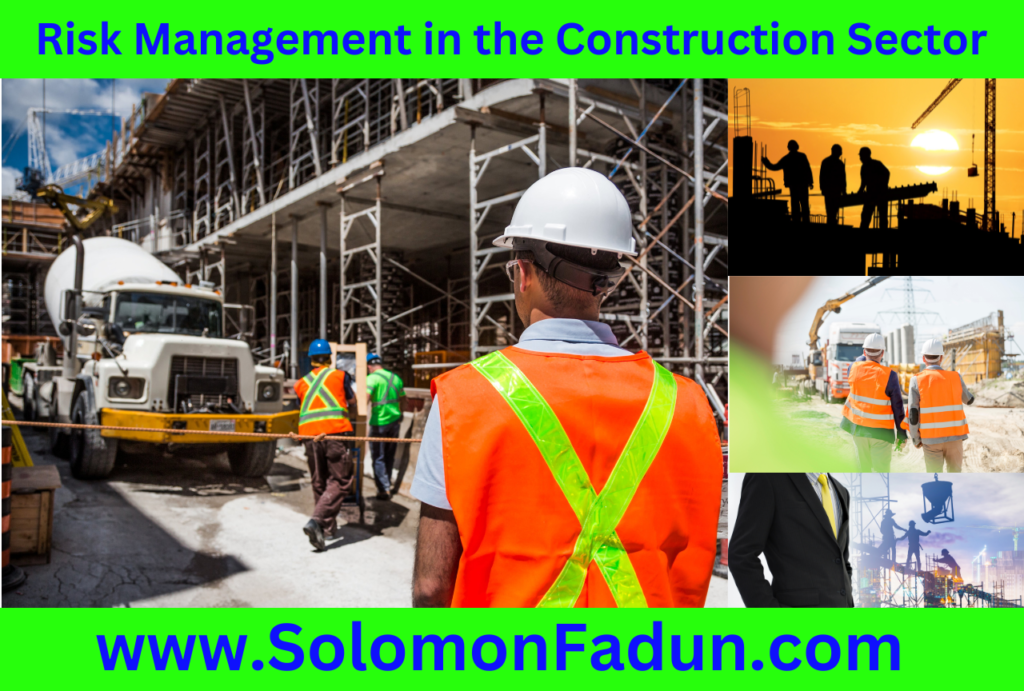Risk Management
in the Construction Sector

This post discusses risk management in the construction sector.
CONSTRUCTION
Construction is a risky business. Each construction project is unique and comes with its own set of challenges and opportunities. Identifying and managing construction project risks can be tricky but possible with careful planning and execution. When risk turns into reality, it can disrupt and derail a project which is why construction risk management is so important. To avoid disaster, you need to be able to properly assess, control, and monitor risks once they have been identified. Risks are not always harmful. Identifying and managing risks effectively can lead to increased profits, establishing good relationships with clients that result in more projects, and expanding your business into new markets and sectors.
RISK MANAGEMENT IN THE CONSTRUCTION SECTOR
Risk management is essential in the construction sector to ensure project planning and management. Construction risk management is designed to plan, monitor and control measures needed to prevent risk exposure. It is also necessary to identify the hazard, assess the extent of the risk, provide measures to maintain it, and manage any residual risks. Various risks associated with construction projects, such as financial, environmental, socio-economic and construction-related risks, are studied and dealt with in risk management. Risk management is a pivotal instrument that helps firms to identify, analyse, and manage risks in the construction sector.
BENEFITS OF RISK MANAGEMENT IN THE CONSTRUCTION SECTOR
It should be evident that a risk management plan can provide your company with great ease and security. Benefits of risk management in the construction sector include:
1. Streamlined operations
2. Enhanced safety
3. Higher confidence in projects
4. Increased profits.
KEY AREAS OF RISK MANAGEMENT IN THE CONSTRUCTION SECTOR
Construction is, without a doubt, a high-risk industry – workers often work from a height, use dangerous tools and machinery, and carry out tasks on hazardous building sites.
Here are 12 critical areas of risk management in the construction industry:
1. Health and Safety
2. Identity
3. Financial
4. Corporate and Professional Standing
5. Anti-Bribery and Corruption
6. Modern Slavery
7. Environmental factor
8. Quality Management
9. Equality
10. Corporate Social Responsibility
11. Information Security and Data Protection
12. Building Information Modelling
TYPES OF RISKS IN CONSTRUCTION PROJECT MANAGEMENT
Construction projects are complex and have several internal and external risks. The significant risks usually associated with construction projects include:
1. Technical Risks: Technical risks include anything restricting you from creating the product that customers want.
2. Logistical Risks: Various logistical risks must be addressed before beginning a project.
3. Financial risks: Inflation, local taxes, and availability and fluctuation in foreign exchange are possible financial risks you might incur during a construction project.
4. Socio-Political risks: Customs and import restrictions and difficulties in disposing of equipment are a few of the socio-political risks you may face during a construction project.
5. Environmental Risk: Environmental risks include natural disasters, weather, and seasonal implications. Floods, earthquakes, and other natural phenomena damage construction sites and make work inaccessible.
6. Management-related risks: Project hazards include poor management of resources, miscalculation of time, lack of sound policies, or misunderstanding of project deliverables.
7. Safety Risk: Safety risk refers to any construction site risks or hazards that can lead to worker accidents.
8. Legal Risk: Potential disputes in the fulfilment of contracts with clients. Legal risks arise from legal and regulatory obligations, including contract risks and litigation brought against the organisation.
9. Job-related Risks: Working at a construction site involves several dangers. Those tasks with different jobs at the site must have the necessary skill set and attention to do the job.
RISK MANAGEMENT PROCESS IN THE CONSTRUCTION SECTOR
The risk management process consists of steps that help identify and manage risks in the construction sector to ensure the successful completion of construction projects. If done correctly and sincerely, construction risk management will reduce the likelihood of an event occurring and the magnitude of its impact. In the simplest terms, the Risk management process is taking pre-emptive actions to avoid and minimise any jeopardy to a project in future. The risk management process in the construction section is also known as the construction risk management process.
There are six basic steps in managing risk in the construction sector, including:
1. Risk identification,
2. Risk assessment,
3. Risk response,
4. Execute a risk management plan,
5. Create contingency plans, and
6. Risk monitoring and control.
See a video on Risk Management in the Construction Sector: https://youtu.be/DCcWQ6k2-Kc

VIDEO TIMESTAMPS
00:00 – Introduction
01:21 – Risk management in the construction industry
02:36 – Benefits of risk management in the construction industry
04:09 – Key areas of risk management in the construction industry
14:43 – Types of risk in construction project management
19:54 – Risk management process in construction project
29:33 – Conclusion

